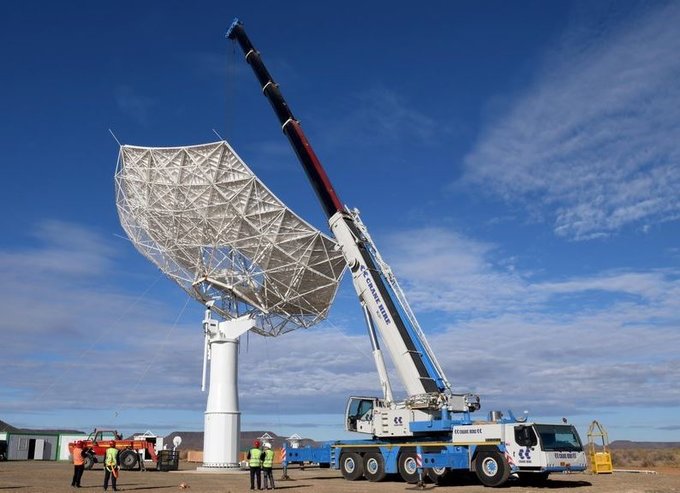Probing the beginning of the Universe can soon be done more accurately
In the Karoo desert in South Africa, scientists from all over the world plan to set up a huge array of telescopes – the Square Kilometer Array (SKA). As many as 200 telescopes will be erected in the next decade, in order to achieve the highest possible precision in measuring radiation from the Universe.

Among the many scientific goals of the SKA are tests of Einstein’s relativity theory, probing the nature of Dark Energy, and studying the properties of our Galaxy, to name just a few.
A team of researchers, amongst them Sebastian von Hausegger, who just finished as a PhD fellow in the Theoretical Particle Physics and Cosmology group of the Niels Bohr Institute, University of Copenhagen, has developed a plan to utilize the very first prototype, the SKA-MPG telescope, in the Karoo in a different way in the near future: the additional knowledge about our Galaxy which this telescope will bring can be used immediately for the study of the Cosmic Microwave Background (CMB), the earliest picture of our Universe.
In a detailed study, they investigate the scientific potential of the SKA-MPG telescope – the prototype for those dishes which eventually should be built into the array is built by the German Max Planck Society – and demonstrate the huge advantage already this single dish will have for cosmology.
This forecast was led by Aritra Basu from Bielefeld University and is now published in Monthly Notices of the Royal Astronomical Society.
Separating the foreground from the background
The Cosmic Microwave Background radiation (CMB) is the afterglow of the forming of our Universe. In this respect, it carries the fingerprint of how everything we know and are came to be.
If analyzed correctly, it will tell us about the very early universe, perhaps including stories about gravitational waves generated by a process called inflation, the currently leading theory of the Universe’s beginning – obviously, we want to be able to study it as closely and accurately as possible.
However, all measurements we attempt to take of the CMB are disturbed by the radiation emitted by our own Galaxy. This radiation is called `foreground emission’ in the CMB community, to distinguish it from the sought-for cosmic `background’. To reliably remove thisforeground, we must understand exactly what it is, and what is causing it. This is where telescopes like the one shown come into play.
Sebastian von Hausegger’s work as a PhD student dealt with the problem of foreground separation. “Essentially, you take a picture of the sky at different frequencies, and by tracing the differences of those pictures, you understand what sort of foreground emission they contain.
Once that is done properly, the real work with interpreting the background can begin”, Sebastian explains. “The more frequencies you take pictures at – the better your understanding gets of the physical processes, the structure, and the composition of the Milky Way!”
The SKA-MPG telescope is able to measure at 2048 different frequencies between 1.7 and 3.5 GHz – many more than previously possible.
Bringing the radio astronomy and the CMB community together
Sebastian continues, “The radio emission of our Galaxy is mainly caused by electrons, zooming around in the Galactic disk, and they can do crazy things. As a part of my PhD, I visited the Astroparticle Physics and Cosmology group at Bielefeld University, Germany.
The group includes experts on galactic radio emission – the emission we call foreground radiation. I visited them as a representative from the CMB research community, so to say. Our own Galaxy is not that interesting in the grand scale of things, but the insight gained from measurements of its emission can sure help us learn about this grand scale! In this collaboration,we tried to bring the two communities closer together.”
Motivated by the properties of the telescope, the authors of this study consider a much more ambitious model for the radio-foregrounds than was done in previous efforts. Even considering the impact of the SKA-MPG prototype alone, the level of achievable detail is much higher than with current data and the inferred prospects for CMB analyses are highly promising.
An array of up to 200 telescopes is the goal
The ambition of the Square Kilometer Array is to finally place 200 telescopes in the South African desert. The reason for choosing a remote area like a desert for performing their measurements the restriction of radio emission in the surroundings(the Karoo desert has been made a so-called Radio Quiet Zone).
The large number of telescopes will give the SKA unprecedented precision. “As we speak, the prototype telescope is being built, and is expected to be completed in the autumn.
It will be very interesting to see what the data will tell us, once it is up – not to mention the future data of the entire array”, says Sebastian.
Scientific publication: Aritra Basu, Dominik J. Schwarz, Hans-Rainer Klöckner, Sebastian von Hausegger, Michael Kramer, Gundolf Wieching, Blakesley Burkhart: CMB Foreground Measurements through Broad-Band Radio Spectro-Polarimetry: Prospects of the SKA-MPG Telescope. MNRAS, https://doi.org/10.1093/mnras/stz1637, published on July 24, 2019. Reprint in arXiv: https://arxiv.org/abs/1906.04788.
Topics
See also:
Contact
Sebastian Domenico von Hausegger, PhD Fellow, Experimental Particle Physics, Niels Bohr Institute, University of Copenhagen, Email: Sebastian.hausegger@nbi.ku.dk Phone: +45 50 20 09 80
